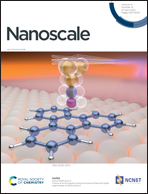Unveiling the advantages of an ultrathin N-doped carbon shell on self-supported tungsten phosphide nanowire arrays for the hydrogen evolution reaction experimentally and theoretically†
Abstract
Packaging electrocatalysts with carbon shells offers an opportunity to develop stable and effective hydrogen evolution reaction (HER) materials. Here, an ultrathin N-doped carbon-coated self-supported WP nanowire array (WP@NC NA) hybrid has been synthesized. Owing to the encapsulation of the ultrathin N-doped carbon shell on the WP surface, the as-prepared WP@NC NA hybrid exhibits enhanced physicochemical stability, more active sites, and superior conductivity compared with WP NA without carbon coating. Besides, density functional theory calculations demonstrate that the carbon shell can optimize the hydrogen adsorption step in the acidic HER, and simultaneously facilitate water physical adsorption, water dissociation, and hydroxyl group desorption steps during the alkaline HER. These findings demonstrate the intrinsic mechanism of how a carbon shell promotes the acidic and alkaline HER kinetics, and provide scientific guidance for the packaging design of promising carbon-encapsulating self-supported electrocatalysts.



 Please wait while we load your content...
Please wait while we load your content...